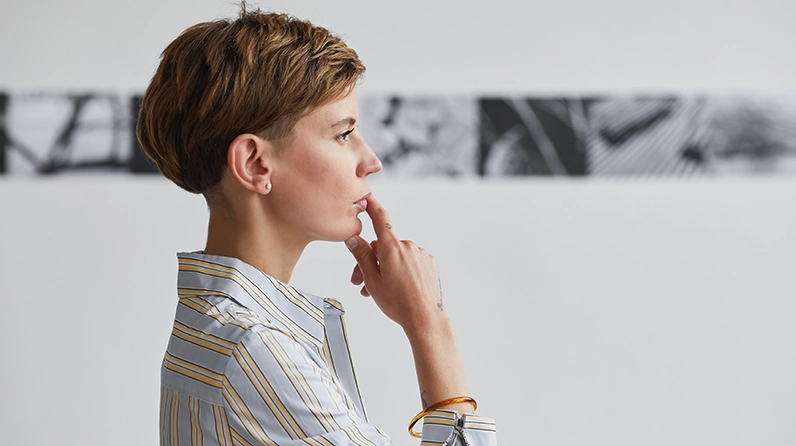

To move from enthusiast to collector, the “secret” is just to dive in.
The art world has always been enticing, at a crossroads of creativity, intellect and talent. Many of us may buy art selectively, but the process of becoming a collector can be more involved—if potentially more personally rewarding. Neuberger Berman has long had a deep association with art. Our co-founder, Roy Neuberger, was a leading collector of contemporary works, many of which are now housed in the Neuberger Museum in Purchase, New York. A corporate art collection has long graced our walls and continues to be an essential part of the NB experience, for employees and clients. In this article, Wealth Advisor Julia Fowler, who worked in the arts prior to finance and has a focus advising arts-related clients, continues in this tradition, sharing reflections on approaching the transition from art enthusiast to collector.
Looking and Learning
While understanding that everyone’s experience may be different, how would you suggest getting started in art collecting?
The idea of buying art, much less “collecting,” can be intimidating. The art world is not always transparent, and can require careful navigation. As obvious as it may sound, a good place to start is simply to look at art—as much as you can. It’s important to get a feel for what you are interested in, and what you like. Bit by bit, your observations can guide you.
If you live in a large cultural center like New York City, there are plenty of museums and galleries to visit. Elsewhere, you can seek out what’s available locally. I grew up in Toledo, Ohio, which has a wonderful museum as well as a few local galleries. Museums often run great education programs, while their membership committees can provide special access to events and tours. They can be an effective place to start your journey. If your town has a graduate art program, “student thesis” art shows can provide opportunities to see new works and meet young artists.
Galleries are another important resource. Though they can have a reputation for exclusivity, galleries are typically free and open to the public. Even the staff at the front desk are often more accessible than you might think; they may not want to intrude, so you might need to approach them with questions, but they are usually very glad to help. Galleries often have specific emphases, so having an art advisor (see below) can help you understand where they fit into the ecosystem and help to facilitate purchases.
Over the past 20 years, art fairs have also become an effective and efficient means to see and buy art. Cities across the world host fairs that, pre-COVID, followed a regular schedule (Miami in December, Mexico City in February, Hong Kong in March, NYC in March and May, Basel in June, etc.). The timing has since shifted, but multiple fairs often occur simultaneously, so you can see a great deal in several days. Periodic exhibitions such as the Venice Biennale provide extensive opportunities to view fine art and are a good excuse to travel as well.
Websites and digital applications have dramatically changed how people access art. How has viewing evolved, and what resources do you find useful?
When I started in the arts, I worked for a collector who received packets of physical slides from artists that he would review and then return. PDFs then helped open up the art market, as images could be sent to collectors around the world. Later, auction houses set up online-only auctions, usually with works at lower price points—though these have gradually crept up.
The COVID pandemic accelerated the shift online. When in-person gallery showings and art fairs weren’t possible, fairs went virtual, with galleries hosting “online viewing rooms” (OVRs) of salable works. Traditionally, galleries hadn’t publicly posted prices for their exhibitions or booths at fairs—you had to request a price list. But with OVRs, prices are generally shown, making things more transparent.
In addition, websites such as Artsy allow you to search available works from a range of galleries and auctions, usually with prices attached. Through OVRs, Artsy and auction previews (via sale estimates), you can get a sense of price and otherwise research a potential purchase, even if not buying online directly. (NFTs are a recent part of the online trend—see our roundtable with Sotheby’s in Investment Quarterly, Winter 2022.)
I find Instagram to be a particularly useful digital resource; I follow artists, galleries, museums, curators, museum directors, art advisors and others, whose posts let me see shows and works I might not otherwise access.
As essential as these online resources are, I think most collectors would still prefer seeing work in person before buying. Color and surface detail can be difficult to capture online, but especially an object’s scale. One of my collector friends will buy online, but only works by artists she already owns or is otherwise very familiar with.
What generally draws individuals to collecting?
People come to collecting from different paths. Sometimes they begin by filling walls in a home, or see their hobby turn into something more meaningful. Others may have a financial motivation. Certain individuals may simply have collecting in their DNA—whether involving art, stamps or sneakers. Years ago, I worked for a wonderful “classic” collector who focused on acquiring works on paper—an interest that arose when, as a child, he was turned off by adults “telling him what to think” about paintings, but who tended to overlook drawings—even by the same artists; there was a closeness to the artist’s “hand” and thought process that he appreciated as well. Collecting became his driving passion, and he was a generous patron to artists and museums. It brought a great richness to his life—not just in living with art, but in the close relationships he developed with artists, curators, gallery owners and many others.
This particular collector had a narrow focus, which sometimes may develop as you gain more experience. This may mean a specific medium (as in his case), time period or genre (still life, landscape, abstract), or works by specific groups, such as women artists.
Tell us about the role of galleries. Why do you feel they are important?
Galleries play a critical role in shaping the careers of many artists. They create the market for the artist, and work thoughtfully to place art with museums and collectors that can be supportive. Each gallery has a program or angle that will likely resonate—or not—with a viewer. It can take time to get to know the various programs, but this can be very worthwhile.
A changing art ecosystem, including the consolidation of galleries (with several mega-names at the global level and many mid-tier and smaller regional galleries) has contributed to the challenge of access, making it harder for newer collectors to obtain works by artists they like. Certain in-demand artists enjoy waitlists, and works may be sold out before an exhibition even opens. In today’s competitive market, relationships that collectors build with galleries are essential, as galleries will often reward collectors they know and respect with access to works as well as guidance with their collecting.
Money, Specialization and Developing an ‘Eye’
How can budgeting come into play? Are some areas of the market suited to new collectors?
A friend who is an art advisor says she starts with new clients by asking, not how they feel about art, but what their budget is. Partly, this is to ground them in the reality of current prices, which have increased markedly in recent years.
Fortunately, not everyone has to focus on “name-brand” paintings and larger works right off the bat, or ever. Prints, drawings and photographs are often a great way to start acquiring art with less of a financial commitment—photographs and prints because they are multiples and not unique works, and drawings because of their usually smaller scale and the shorter time typically required to produce them. Within each of these categories, particular nuances are important to understand. For example, both prints and photographs have edition sizes and technical elements that can affect value.
Can anyone develop an eye for art?
For me, one of the great things about joining Neuberger Berman has been the legacy of our founder, Roy Neuberger, who was a leading collector of works by contemporary artists, many of whom are now household names. I bring this up because you’ve mentioned a celebrated concept in the arts, which is one’s “eye.” Some collectors seem to be born with this quality, but I would say that for most of us it’s largely a function of looking at many, many artworks.
Once you’ve seen a lot of art, work that is different and strong begins to stand out. Recently, there's been a trend toward figurative art. Before that, “zombie formalism”—a trend in abstract painting—had a prominent phase. Even amid such trends, an artist may be doing something different and striking or thoughtful—and noticing these qualities may be a result of developing your eye for art.
How does broader knowledge of art history and technique help with understanding an artwork?
Overall, a lot of background and context goes into what makes a piece of art worth something, and also resonate, that may not be evident at first. When looking at a work of art, I try to recall that each brushstroke or frame of a photograph was a deliberate choice made by the artist, and that those decisions come from people who are usually deeply steeped in the history of their craft.
While not necessary, it can be helpful to read a little art history and have a sense of where art is today versus in the past, and what it is responding to. If I were to give one art historical tip, it would be to read up on Marcel Duchamp, an early 20th century artist whose “ready-mades” took everyday objects and called them art, and, in doing so, turned the focus to the idea of the work of art rather than the object itself.
Advisors, Estate Planning and Other Concerns
Should new collectors consider hiring an art advisor?
For the serious beginning collector, I believe an experienced art advisor can be an extremely useful partner: They can help educate you; they can help you get a sense of your budget, and then work within that budget on developing your collection; and they can facilitate your navigation of the art world given their familiarity with the programs of different galleries, auction calendars and bidding, sales negotiations and more. Advisors usually have longstanding relationships with galleries, and can help you access works and alert you when they become available.
An experienced art advisor can help clarify what interests you, and what you respond to, as well as what may be a solid “investment” over the long term. They will typically know what an artist has sold historically and for what prices. And they can also help find pieces that otherwise wouldn’t get your attention.
What are some issues we haven’t discussed?
I would point to certain practical needs, including insurance for your artworks and keeping good records of your art purchases, even a database once you have achieved critical mass. As with other assets, it’s important to keep in mind how the art you own is titled.
Over time, estate planning may also come into play, around which you will need to consider your ultimate objectives. Will you plan on leaving it to your children? If so, how will you choose who gets what, given the typical uncertainty around valuation. Should you set up an LLC as a vehicle to hold the art and for gifting interests to trusts? Will you plan on donating the works? If so, where would make the most sense—and does that museum want only particular pieces? Would you consider establishing your own foundation?
Such ideas may sound far removed from your initial steps into the art world, but I believe careful planning is always important, whether in constructing a financial portfolio or building out an art collection.
Any final thoughts for readers?
Despite moves toward openness, the art world can still feel like an opaque place. The “way in,” in my view, largely involves simply getting started: looking at works, reading up and making connections.
Becoming a collector is an evolutionary process. As you become more knowledgeable and reflective about what really interests you, that can reinforce your confidence in making purchases and help guide your overall strategy. It’s a wonderful journey and I wish anyone who embarks on it the best of luck.
Resources
In addition to museums and galleries, various tools and resources can help you build knowledge and keep you current on the art world.
Gallery apps. I rely on a number of mobile applications, including See Saw, which lists galleries in various cities; in Paris or Berlin, for example, you can easily find and map shows of interest; in New York, listings are broken down by neighborhood. ARTFORUM offers a similar app.
Newsletters. ARTnews, Artnet and ARTFORUM are a few sources for daily or weekly newsletters. These can be a bit overwhelming, but provide valuable information about exhibitions and other upcoming events and general art news. You can also join mailing lists for galleries, museums and other art nonprofits, as well as art fairs and auction houses.
Instagram. Artists often maintain an extensive presence on Instagram, as do galleries, critics, museums and a host of others. Building your “feed” of sources can help with immersion in the art world.
Auction previews. Previews are typically open to the public, so you don’t need an appointment or special invitation, and you can sign up in advance to receive auction notices.
Student art shows. Viewing the work of young or emerging artists can be educational as you progress on your journey. Many incredible artists have come out of Master of Fine Arts programs.
Art fairs. Art Basel, Frieze, TEFAF, Independent, NADA, Zona Maco and ARCO are among the largest fairs, but there are many others. Visit their websites (or join their newsletters) to obtain schedules. Becoming a “VIP” can provide early access to these events.
Association of Professional Art Advisors. The APAA’s website (www.artadvisors.org) can be helpful in finding an art advisor, with a directory organized by region and area of specialization.
– Julia Fowler
Related Insights


INSIGHTS
Using Tax-Free Gifts for Wealth Transfer

INSIGHTS
CIO Notebook: Powell Plays the Middle as Fed Cuts Rates

INSIGHTS
CIO Notebook: September U.S. Non-Farm Payrolls Further Complicate the Narrative
This material is provided for informational purposes only and nothing herein constitutes investment, legal, accounting or tax advice, or a recommendation to buy, sell or hold a security. This material is general in nature and is not directed to any category of investors and should not be regarded as individualized, a recommendation, investment advice or a suggestion to engage in or refrain from any investment-related course of action. Investment decisions and the appropriateness of this material should be made based on an investor’s individual objectives and circumstances and in consultation with his or her advisors. This material is not intended as a formal research report and should not be relied upon as a basis for making an investment decision. The firm, its employees and advisory clients may hold positions within sectors discussed, including any companies specifically identified. Specific securities identified and described do not represent all of the securities purchased, sold or recommended for advisory clients. It should not be assumed that any investments in securities, companies, sectors or markets identified and described were or will be profitable. Neuberger Berman, as well as its employees, does not provide tax or legal advice. You should consult your accountant, tax adviser and/or attorney for advice concerning your particular circumstances. Information is obtained from sources deemed reliable, but there is no representation or warranty as to its accuracy, completeness or reliability. All information is current as of the date of this material and is subject to change without notice. Third-party economic or market estimates discussed herein may or may not be realized and no opinion or representation is being given regarding such estimates. Neuberger Berman products and services may not be available in all jurisdictions or to all client types. The use of tools cannot guarantee performance. Diversification does not guarantee profit or protect against loss in declining markets. As with any investment, there is the possibility of profit as well as the risk of loss. Investing entails risks, including possible loss of principal. Investments in hedge funds and private equity are speculative and involve a higher degree of risk than more traditional investments. Investments in hedge funds and private equity are intended for sophisticated investors only. Unless otherwise indicated, returns reflect reinvestment of dividends and distributions. Indexes are unmanaged and are not available for direct investment. Past performance is no guarantee of future results.
This material may include estimates, outlooks, projections and other “forward-looking statements.” Due to a variety of factors, actual events or market behavior may differ significantly from any views expressed or any historical results. Nothing herein constitutes a prediction or projection of future events or future market or economic behavior. The duration and characteristics of past market/economic cycles and market behavior, including length and recovery time of past recessions and market downturns, is no indication of the duration and characteristics of any current or future market/economic cycles or behavior.
Tax planning and trust and estate administration services are offered by Neuberger Berman Trust Company. “Neuberger Berman Trust Company” is a trade name used by Neuberger Berman Trust Company N.A. and Neuberger Berman Trust Company of Delaware N.A., which are affiliates of Neuberger Berman Group LLC.
Hypothetical growth examples are for informational and educational purposes only.
Links to third-party websites are furnished for convenience purposes only. The inclusion of such links does not imply any endorsement, approval, investigation, verification or monitoring Neuberger Berman us of any content or information contained within or accessible from the linked sites.
For more information on COVID-19, please refer to the Centers for Disease Control and Prevention at cdc.gov.
Neuberger Berman Investment Advisers LLC is a registered investment adviser. The “Neuberger Berman” name and logo are registered service marks of Neuberger Berman Group LLC.